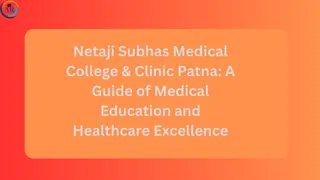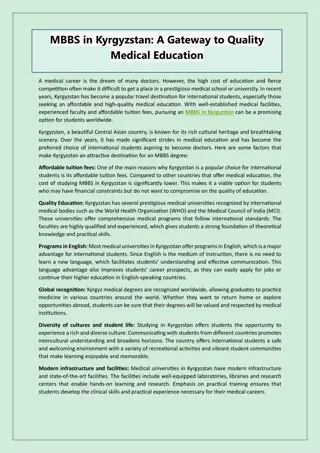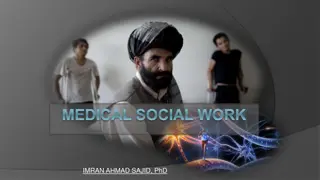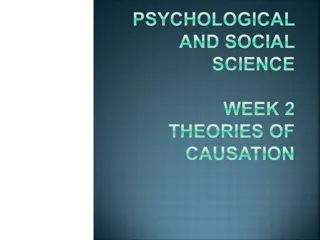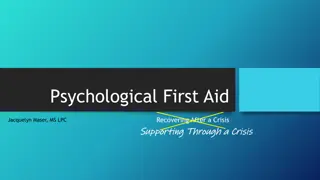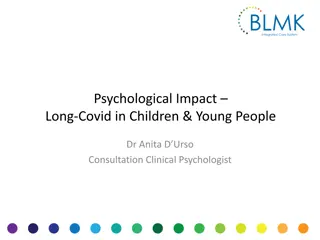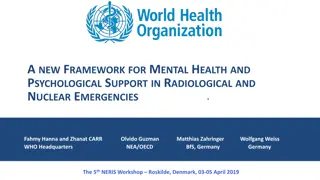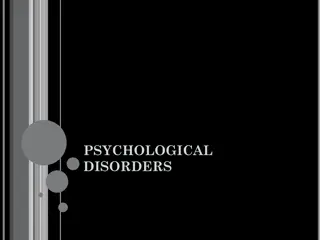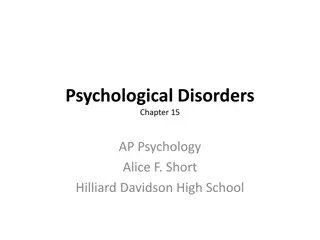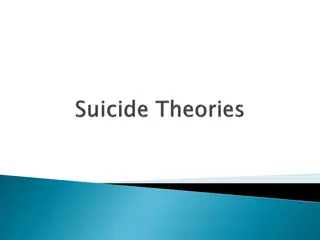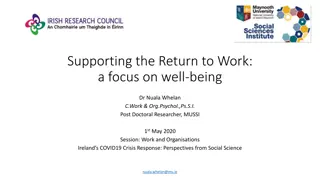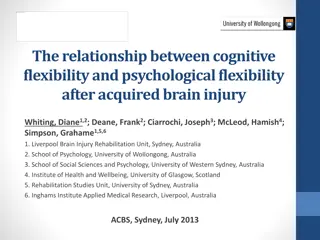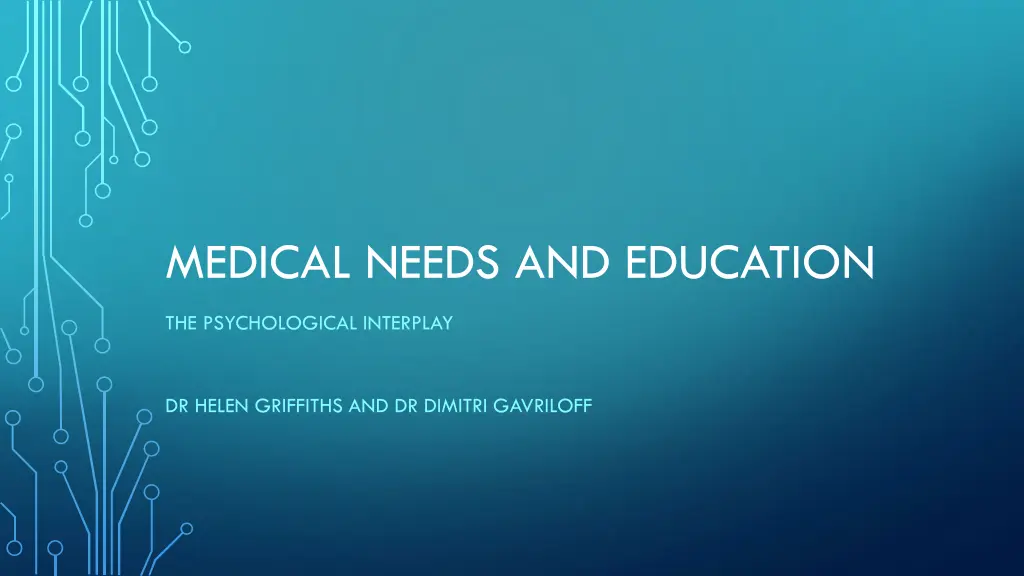
Understanding Mental Health Difficulties in Children and Adolescents
Explore the complex interplay between medical needs, education, and psychological factors in addressing mental health issues in children and adolescents. Gain insights into common mental health difficulties, such as anxiety, self-harm, and suicide risks, while learning about increased vulnerability factors. Enhance your knowledge through quizzes and small group activities focused on mental health awareness.
Download Presentation

Please find below an Image/Link to download the presentation.
The content on the website is provided AS IS for your information and personal use only. It may not be sold, licensed, or shared on other websites without obtaining consent from the author. If you encounter any issues during the download, it is possible that the publisher has removed the file from their server.
You are allowed to download the files provided on this website for personal or commercial use, subject to the condition that they are used lawfully. All files are the property of their respective owners.
The content on the website is provided AS IS for your information and personal use only. It may not be sold, licensed, or shared on other websites without obtaining consent from the author.
E N D
Presentation Transcript
MEDICAL NEEDS AND EDUCATION THE PSYCHOLOGICAL INTERPLAY DR HELEN GRIFFITHS AND DR DIMITRI GAVRILOFF
MEDICAL NEEDS Education Physical Health Mental Health
QUIZ PLEASE USE YOUR ANSWER SHEETS IN YOUR PACK WE ARE PLAYING FOR FUN!
MENTAL HEALTH OVERVIEW 1 in10 5-15 year olds are affected by mental health problems (2004) Thames Valley area 7.7% Range of difficulties from brief episodes of anxiety to severe and enduring conditions e.g. eating disorders Growing awareness and interventions locally in school based settings which do you know about?
INCREASED RISK OF MENTAL HEALTH DIFFICULTIES Children in the criminal justice system Looked after children Children in care Children identifying as lesbian, gay, bisexual, trans Children with physical disabilities Children with learning disabilities
SELF HARM AND SUICIDE 922 suicides in under 25s between Jan 2014 and Dec 2015 Just over half had (known) previous self harm 60% had some contact with mental health services Significant proportion not in contact with mental health services How confident are you in identifying children at risk of self harm/suicidal ideation/mental health difficulties? What are your gaps /worries?
IN SMALL GROUPS OF 4-5, USE THE WORK SHEETS IN FRONT OF YOU TO WRITE DOWN AS MUCH AS YOU KNOW ABOUT THE MENTAL HEALTH DIFFICULTY ON YOUR SHEET FEEDBACK TO LARGE GROUP/DISCUSSION OF FORMAL CRITERIA
ANXIETY Excessive fear and anxiety, and associated behavioural disturbances Fear = the emotional response to threat Anxiety = the anticipation of future threat Clinically significant distress Generalised anxiety disorder: at least 6 months, 3 or more symptoms, difficult to control Specific phobia: fear, anxiety or avoidance induced by a specific situation Panic disorder: recurrent and unexpected panic attacks or changes behaviour to prevent panic attacks
DEPRESSION Lasting over 2 weeks, almost every day 5 out of the below Depressed mood/irritable (feeling sad, empty) Decreased interest / pleasure Changes to weight, appetite, sleep, activity, energy, concentration Guilt/worthlessness Suicidality Categorised in terms of level of severity
ADJUSTMENT (DISORDER) Emotional and behavioural symptoms in the presence of a stressor occurring within 3 months of the onset of distress Distress is out of proportion OR causing clinically significant impairment Distress must be related to the stressor and not an escalation of a pre existing mental health condition Isnt part of normal bereavement Once stressor is removed or is adjusting, symptoms subside within 6 months
EATING DISORDERS Anorexia Nervosa Persistent restriction of energy intake leading to significantly low body weight Intense fear of gaining weight or of becoming fat, or persistent behaviour that interferes with weight gain Disturbance in the way one's body weight or shape is experienced, undue influence of body shape and weight on self-evaluation, or persistent lack of recognition of the seriousness of the Bulimia Nervosa Recurrent episodes of binge eating. An episode of binge eating is characterised by both of the following: Eating, in a discrete period of time an amount of food that is definitely larger than most people would eat during a similar period of time and under similar circumstances. A sense of lack of control over eating during the episode Recurrent inappropriate compensatory behaviour in order to prevent weight gain, The binge eating and inappropriate compensatory behaviours both occur, on average, at least once a week for three months. Self-evaluation is unduly influenced by body shape and weight.
POST-TRAUMATIC STRESS DISORDER Exposure to actual or threat of death, serious injury or sexual violence (including witnessing or exposure to details) Intrusive symptoms: Re-experiencing, dreams Arousal: irritability, angry outbursts, hypervigilance, startle response Avoidance: of internal (cognitive) or external reminders Alteration in mood or cognition: amnesia, persistent shame/guilt/sadness, detachment Duration longer than 1 month Clinically significant impairment How might this manifest in school?
PSYCHOSIS/SCHIZOPHRENIA Delusions/Hallucinations/Disorganised speech and/or behaviours Diminished emotional expression Reduced functioning Signs to look out for? Interactions with medication / treatment
ANXIETY SYMPTOMS: FIGHT OR FLIGHT - A RANGE OF EVOLUTIONARILY ADVANTAGEOUS PHYSICAL CHANGES COMMON TO MAMMALS - HELPFUL FOR DEALING WITH ACUTE THREAT (E.G. CAR SCREECHING TOWARD US) - BRAIN STRUGGLES TO DIFFERENTIATE BETWEEN IMAGINED THREAT AND OBJECTIVE THREAT.
COMMON PHYSICAL HEALTH CONDITIONS Genetic Disorders Diabetes Cystic Fibrosis Chronic Pain Cancer Neuromuscular Conditions Precocious Puberty Too Many to List! Cerebral Palsy Arthritis
MEDICALLY UNEXPLAINED SYMPTOMS What do we think of? What words come to mind? How easy is it to manage in school?
COMMON MUS Pain Headaches Fatigue Nausea Dizziness
MUPS (FUNCTIONAL DISORDER, NON-ORGANIC, PSEUDO ) MUS are common, accounting for as many as one in five new consultations in primary care. Between 20% and 30% of consultations in primary care are with people who are experiencing MUS and have no clear medical diagnosis. It is estimated that this rises to an average of 52% in secondary care where a substantial proportion of secondary care resources are used by frequent attenders whose symptoms remain unexplained. About one in 10 children and adolescents suffer from this condition. Common symptoms are headaches, stomach aches, joint pains and tiredness. Less commonly, young people can have significant unexplained physical symptoms, including muscle weakness, collapses, fit-like episodes, and severe and chronic pain.
CONCEPTUALISING MUS WHAT ARE THE UNDERPINNINGS? WHAT KEEPS IT GOING? HOW IS IT TREATED?
MEDICALLY UNEXPLAINED SYMPTOMS (FUNCTIONAL SYMPTOMS) - Because there is no damage to the nervous system, routine medical investigations (e.g. scans, blood tests) produce no definitive indications. - Not all in the mind but as yet poorly understood by medical science. Evidence suggests problems in brain sending and receiving neuronal information i.e. a problem with the function of the nervous system. - Like having software problem on a computer, rather than a hardware problem. - Can often be treated and/or managed effectively with multi-disciplinary approaches (usually Med/Psych/Physio/OT) but require a concerted effort from everyone (patient themselves, family, school, work etc). - Biopsychosocial approach to make sense of predisposing, precipitating and perpetuating factors. Understanding is key.
UNDERSTANDING SYMPTOMS Biological Psychological Social Predisposing Genetic factors / Structural Disease Personality Traits Depression / Anxiety Adverse experiences Precipitating Physical injury / illness Acute dissociation Concern / attention about bodily symptoms Stressful life events Perpetuating Changes in nervous system function Worry about cause Avoidance of symptom provocation Anger Frustration Depression Not being believed / Stigma of an undiagnosed illness / Loss of job/independent income Subtle neuroendocrine changes www.neurosymptoms.org
FABRICTED/INDUCED ILLNESS Reported symptoms not present & signs not observed by others, or independently of parent Reported symptoms & signs not explained by child s medical condition, if any Physical examination & results of investigations do not explain reported symptoms or signs Inexplicably poor response to medication or procedures Reporting of new symptoms Continuum approach to severity not always a child protection issue? Good communication between services is critical!
IN WHAT WAYS DO MEDICAL NEEDS IMPACT ON A CHILD IN THE EDUCATION SETTING? EDUCATIONAL, SOCIAL, EMOTIONAL ETC LARGE GROUP DISCUSSION
WHAT ARE ALL THE IMPACTS OF: Playing catch up Lower achievement Fewer social experiences Feeling different Missing Lessons (Appointments, unwell etc) Reduced sleep Reduced cognitive functioning Reduced physical activity Reduced attention Pain Answering questions from others Feeling stared at Feeling different (usually negatively) to others Mental health difficulties? Looking Different
INTERACTIONS BETWEEN PHYSICAL AND MENTAL HEALTH Psychological adaptation not predicted by severity of illness/impairment (O Malley et al, 1980). What does? Reciprocal impact of mental and physical health. What is the impact of depression on adhering to a medical regime? If you look different, how may you feel about yourself? Children and young people are incredibly resilient! But we know that children with medical needs are at increased risk of psychological difficulty! Psychological difficulty in childhood may predict poorer long term physical and mental health outcomes
MEDICAL NEEDS AND SCHOOLS Tier 1 /Universal services often key in identifying mental health difficulties Schools can sometimes be the main place for intervention why? 70% of secondary schools and 52% of primary schools offer counselling Children would like more information and education on mental health, reducing stigma and increasing understanding what are the gaps in your school?
SCHOOLS AND MEDICAL NEEDS (2016) Tackling bullying Promoting wellbeing Identifying problems Positive relationships Celebrating difference
WHY IS IT IMPORTANT? Good multidisciplinary management of medical needs means: Reduced physical effects of condition (pain, fatigue, unmanaged medical needs) Reduced absenteeism (= improved safeguarding) Increased social and emotional development Increased participation in school life Lower risk of associated psychological difficulty (anxiety, depression, adjustment) Increased educational achievement Reach full potential!
THINKING ABOUT THE HOLISTIC NEEDS OF CHILDREN WITH MEDICAL NEEDS IN AN EDUCATION SETTING
JOANNA, 9 Joanna has asthma and allergies, and needs to take an inhaler. She also appears quite an anxious child, and often needs to leave lessons to take a few minutes and seems panicky about needing her inhaler. She is supported by the class TA to return to the lesson. It s not always clear whether she needs her inhaler or whether she is anxious but you tend to allow her to have it just to be on the safe side.
CASE STUDY Emily is an 8 year old girl who has been treated for cancer. She still experiences pain and fatigue following the end of her treatment, and is reluctant to go onto the playground or take part in PE as she isn t as agile and quick as she used to be. She worries her friends will think she is still unwell and so tends to say she feels sick. In class, when it is time for maths, she gets a tight chest and needs to leave the classroom. Her teachers are unsure how much to encourage her on the playground is she physically able to join in? Is the chest pain anything to worry about?
CASE STUDY John is a 12 year old boy with a history of pain and fatigue, for which no medical cause has been identified. He seems to experience a high level of general anxiety and struggles with the school environment. He is under lots of doctors at the children s hospital who have advised that there is no medical cause and that he can be in school. John is frequently absent and when he is in school, he complains of pain and leaves the classroom. He spends much of his time in the school office area until his parents can collect him.
QUESTIONS What are the potential impacts of the medical needs on: Education What kind of things might you need to think about in your setting? Other aspects of wellbeing What might you be asked to implement? What supports/resources do you have to inform your work? How would you implement it?
END OF DAY TASKS/REFLECTIONS Feedback questionnaires What will you tell your colleagues about today? Is there anything you will action or do differently? Is there anything that you would like to hear more of during the next 2 training days? How can being a partnership school help you?



